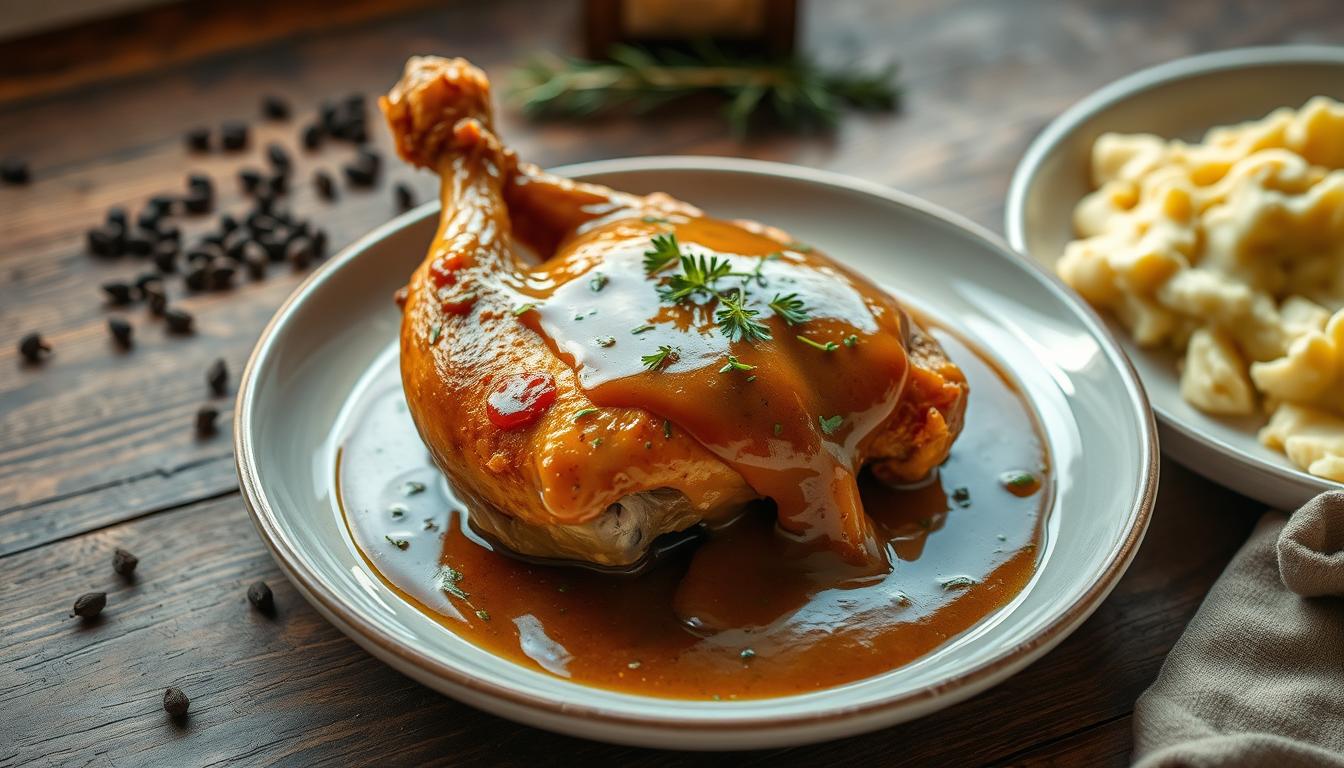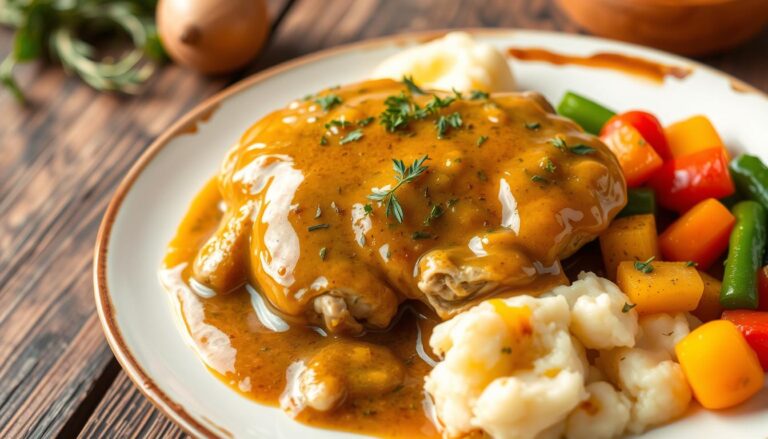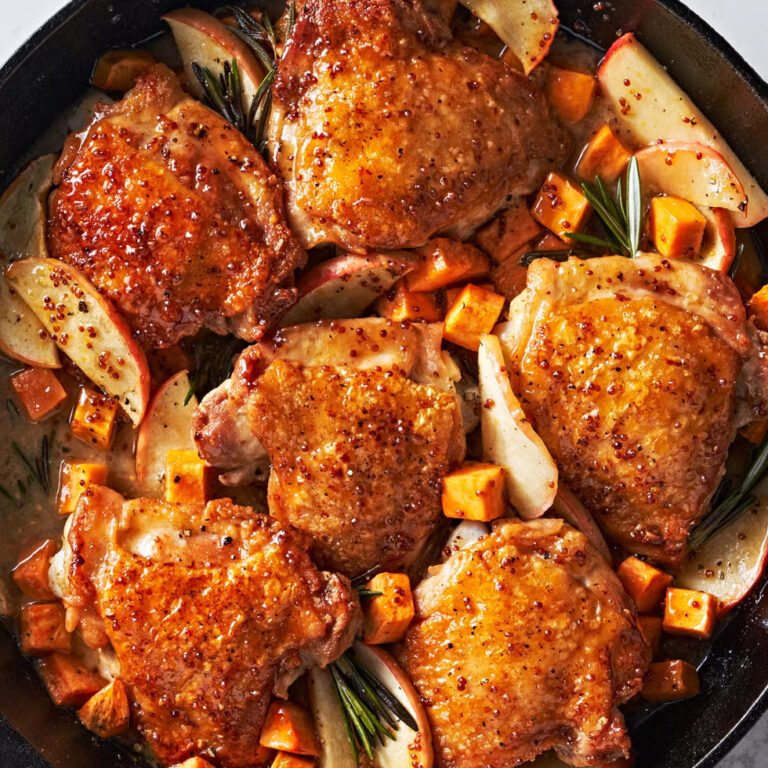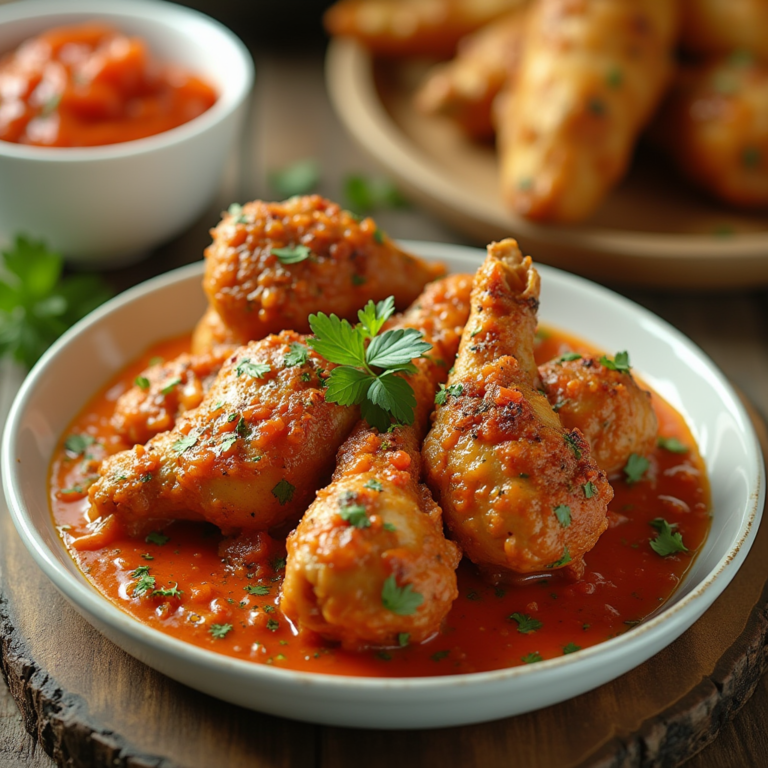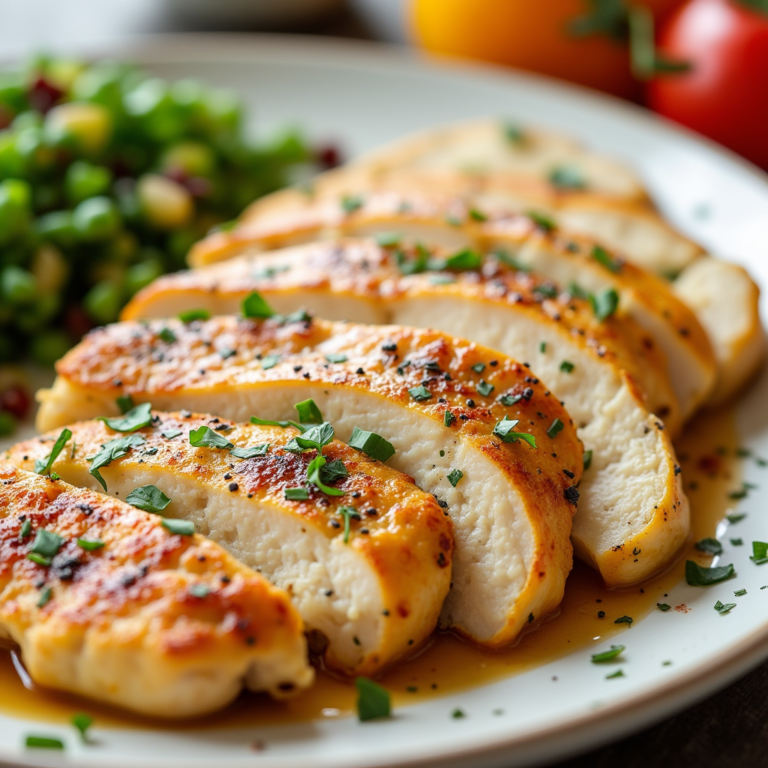Easy Homemade Chicken and Gravy Recipe You’ll Love
Easy Homemade Chicken and Gravy Recipe You’ll Love, Imagine a dish that takes you back to home’s comfort. The smell of sizzling chicken and smooth gravy fills the air. The first bite makes you sigh with happiness. This classic comfort food, chicken and gravy, is loved by many. It’s easy to make and full of flavor, making it a family favorite.
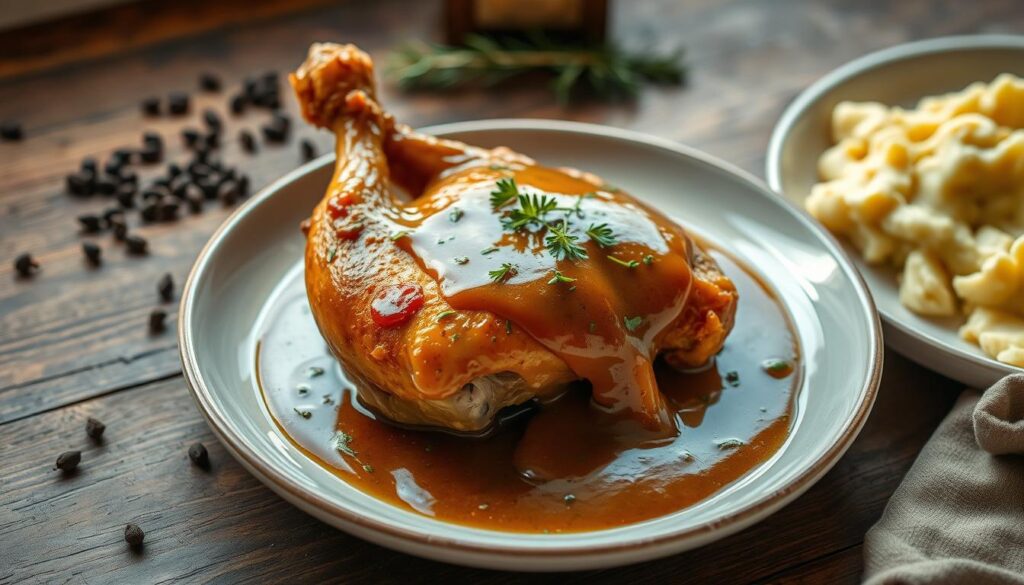
Key Takeaways
- Homemade chicken and gravy is a classic comfort food that’s easy to prepare.
- The dish features tender, juicy chicken smothered in a rich, creamy gravy.
- It’s a versatile meal that can be paired with a variety of side dishes.
- The recipe is suitable for both novice and experienced home cooks.
- Chicken and gravy is a comforting and satisfying meal that the whole family will enjoy.
Why This Classic Comfort Food Will Become Your Family’s Favorite
Chicken and gravy is a beloved southern cuisine dish in many American families. It’s known for its rich flavors and tender poultry. This classic meal has been a favorite for generations.
The History of Southern-Style Chicken and Gravy
This comforting dish comes from the American South’s culinary traditions. Traditional flavors and local ingredients have shaped its iconic taste. Chicken and gravy was a way to make the most of simple ingredients, turning them into a satisfying meal.
Health Benefits of Home-Cooked Poultry Dishes
Easy Homemade Chicken and Gravy Recipe You’ll Love is not just tasty; it’s also good for you. It’s healthier than processed or fast food because it’s lower in sodium and unhealthy fats. The protein in chicken also supports your health.
“Chicken and gravy is more than just a meal – it’s a cherished tradition that brings families together and nourishes the soul.”
Chicken and gravy’s history, comforting taste, and health benefits make it a favorite in many homes. Enjoying it will show you why it’s a beloved dish for families.
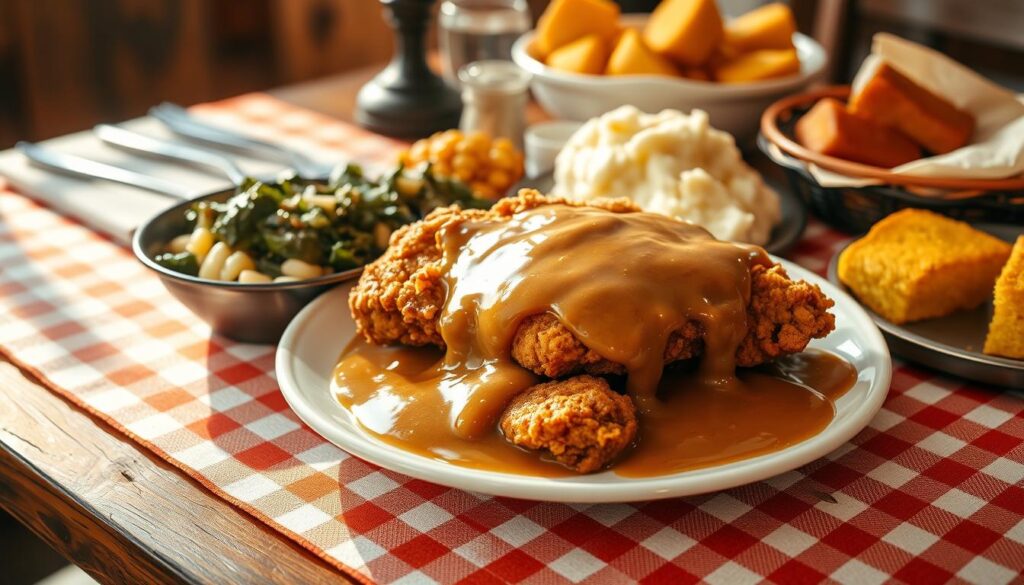
Essential Ingredients for Perfect Chicken and Gravy Recipe
Creating a delicious chicken and gravy dish starts with the right ingredients. This classic comfort food needs a mix of easy recipes and pantry ingredients for the best taste. Let’s look at the key parts that make this dish a hit in any kitchen.
The chicken is the main ingredient. Use fresh, high-quality chicken breasts or thighs for the best taste. You’ll also need basic items like all-purpose flour, butter, and chicken broth for the gravy.
- Chicken (breasts or thighs)
- All-purpose flour
- Butter
- Chicken broth
- Milk (optional, for creamier gravy)
- Salt and pepper
- Garlic powder (for added flavor)
- Onion powder (for depth of flavor)
The flour and butter make the roux, the gravy’s base. The chicken broth and milk (if using) add the liquid. Seasoning with salt, pepper, garlic powder, and onion powder makes the gravy taste great, matching the chicken’s tenderness.
“The secret to the best chicken and gravy is in the balance of the ingredients. Each one plays a crucial role in creating that comforting, homemade flavor.”
With these easy recipes and pantry ingredients, you’re ready to make great chicken and gravy. Next, we’ll look at the kitchen tools you need to make this dish.
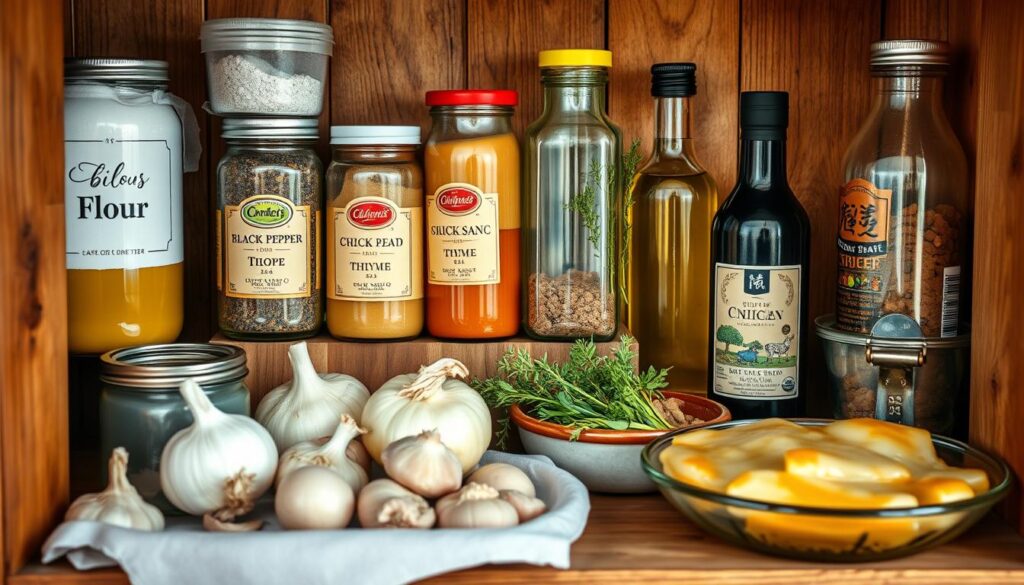
Kitchen Equipment You’ll Need
Having the right kitchen tools is crucial for home cooking. For a perfect chicken and gravy dish, you’ll need some key cookware and optional tools. These will help you get restaurant-quality results at home.
Must-Have Cookware
- A large, heavy-duty skillet or Dutch oven: This will be your primary cooking vessel for searing the chicken and simmering the gravy.
- A sharp chef’s knife: A quality knife is essential for effortlessly cutting and trimming the chicken.
- A sturdy cutting board: Provide a stable surface for preparing your ingredients.
- A whisk: This handy tool will help you achieve a smooth, lump-free gravy.
Optional Tools for Better Results
While the essentials listed above are all you truly need, there are some additional kitchen equipment that can take your chicken and gravy to the next level:
- A meat thermometer: Ensure your chicken is cooked to the perfect internal temperature for food safety and juicy tenderness.
- A gravy separator: This specialized tool will help you easily remove excess fat from the gravy, resulting in a silkier texture.
- A slow cooker or Instant Pot: These appliances can simplify the cooking process and make the chicken extra tender.
Measuring Equipment
Precise measurements are key when preparing the gravy. Be sure to have the following on hand:
- Measuring cups for dry and liquid ingredients
- Measuring spoons for accurate seasoning
With the right kitchen equipment, you’ll be well on your way to creating a delicious home-cooked chicken and gravy dish that your family will love. Invest in these essential tools and enjoy the process of mastering this classic comfort food.
Preparing Your Chicken for Maximum Flavor
To make your poultry dishes taste better, start with the right prep. Follow these steps to bring out the best in your chicken. This will make your seasoning techniques shine.
- Thoroughly clean the chicken: Rinse the chicken under cold running water, pat it dry with paper towels, and remove any visible fat or skin imperfections.
- Brine the chicken (optional): Submerge the chicken in a saltwater brine for 30 minutes to an hour. This helps the meat retain moisture during cooking.
- Generously season the chicken: Rub the chicken with a blend of your favorite spices, herbs, and seasonings. Don’t be shy – a flavorful exterior will translate to juicy, delicious meat.
- Let the chicken rest: Allow the seasoned chicken to sit at room temperature for 30 minutes before cooking. This helps the flavors meld and ensures even cooking.
By following these simple steps, you’ll make your poultry dishes unforgettable. Your family and friends will love the seasoning techniques-infused chicken.
| Seasoning Blend Idea | Ingredients |
|---|---|
| Classic Poultry Seasoning | Sage, thyme, rosemary, black pepper, garlic powder |
| Lemon-Herb Chicken | Lemon zest, parsley, oregano, paprika, salt, pepper |
| Cajun-Inspired Blend | Cayenne, chili powder, garlic powder, onion powder, paprika, salt |
“The secret to exceptional poultry dishes lies in the preparation. Invest a little extra time and care, and you’ll be rewarded with a masterpiece of seasoning techniques.”
Mastering the Art of Gravy Making
Making the perfect gravy is an art that can make your chicken and gravy dish stand out. Whether you want traditional Southern flavors or something new, learning how to make gravy is key. We’ll share the secrets to a smooth, tasty gravy that everyone will love.
Common Gravy Mistakes to Avoid
Problems like lumpy, watery, or too thick gravy can be a bummer. To avoid these issues, it’s crucial to avoid common mistakes. These include not whisking or stirring enough, using the wrong thickener, simmering too long, and adding too much liquid.
- Not properly whisking or stirring the gravy while it’s cooking
- Using the wrong type or amount of thickener
- Letting the gravy simmer for too long, causing it to reduce excessively
- Adding too much liquid at once, resulting in a thin, watery consistency
Tips for Smooth, Lump-Free Gravy
Getting a smooth gravy is all about the right technique. Here are some tips to help you get it right:
- Start with a roux made from equal parts fat (from the chicken drippings) and flour, cooking it until it’s a rich, golden brown.
- Gradually add your liquid (chicken broth or milk) to the roux, whisking continuously to prevent lumps from forming.
- Simmer the gravy, stirring frequently, until it reaches your desired thickness.
- For an extra-smooth texture, consider straining the gravy through a fine-mesh sieve before serving.
Adjusting Seasoning and Consistency
Seasoning and consistency are crucial for the perfect gravy. Taste your gravy as it simmers and adjust the seasoning as needed. Add more salt, pepper, or herbs to get the flavors you want. If it’s too thin, add more roux or simmer longer. If it’s too thick, add more liquid until it’s right.
“The secret to great gravy is patience and attention to detail. Take your time, and don’t be afraid to experiment with different techniques and seasonings until you find the perfect balance of flavors.”
Step-by-Step Cooking Instructions
Making a tasty chicken and gravy dish is easy. Just follow these simple steps to make a meal that everyone will enjoy. It’s perfect for a family dinner that will leave everyone wanting more.
- First, season the chicken with salt, pepper, and any other spices you like. Make sure to cover all sides of the chicken evenly.
- Heat a few tablespoons of oil in a large skillet or Dutch oven over medium-high heat. Add the seasoned chicken and cook until it’s browned on both sides, about 3-4 minutes each side.
- After the chicken is browned, take it out of the skillet and set it aside. Then, add the chopped onions to the pan and cook until they’re translucent, about 5 minutes.
- Add the all-purpose flour to the onions and whisk it in to make a roux. Cook the roux for 2-3 minutes, stirring constantly, until the flour loses its raw taste.
- Pour in the chicken broth slowly, whisking constantly to avoid lumps. Let it simmer for 5-7 minutes, or until the gravy thickens to your liking.
- Put the browned chicken back in the gravy and cover the pan. Lower the heat to low and let it simmer for 25-30 minutes. This will ensure the chicken is fully cooked and reaches an internal temperature of 165°F.
- Once the chicken is cooked, taste the gravy and adjust the seasoning if needed. Add more salt, pepper, or spices to match your taste.
By following these simple recipes, you can make a delicious chicken and gravy dish. Serve it over mashed potatoes, rice, or your favorite side dish for a complete meal that everyone will love.
Serving Suggestions and Side Dish Pairings
There are many ways to serve your homemade chicken and gravy. This classic southern cuisine dish goes well with different sides. You can choose from traditional or modern options to make a hearty meal.
Traditional Southern Sides
- Creamy mashed potatoes
- Buttery biscuits
- Tender collard greens
- Perfectly cooked cornbread
- Savory mac and cheese
Modern Accompaniments
- Roasted Brussels sprouts with a touch of lemon
- Garlic-infused green beans
- Herb-seasoned wild rice pilaf
- Crisp, fresh garden salad
- Buttery mashed cauliflower
Choose sides that let the chicken and gravy be the star. Pick dishes that enhance the meal’s richness and warmth. Serve the chicken and gravy over mashed potatoes or with biscuits for a classic look. For something new, try it with roasted veggies or a fresh salad to balance the meal.
“The key to a perfect chicken and gravy dish is in the balance of flavors and textures. The right side dishes can truly elevate the entire meal.”
Storage Tips and Reheating Guidelines
Storing and reheating your homemade chicken and gravy right is crucial. It keeps the taste and texture just right. Whether you have leftovers or are planning ahead, here are some tips to keep your meal fresh and safe.
Refrigerating Chicken and Gravy
Put leftover chicken and gravy in an airtight container in the fridge. It stays good for 3-4 days. When you reheat, make sure it gets to 165°F to maintain food safety.
Freezing for Longer Storage
- Divide the chicken and gravy into single-serving portions before freezing for easy reheating.
- Freeze in an airtight container or freezer-safe bag for up to 3 months.
- Thaw in the refrigerator overnight before reheating.
Reheating Tips
- For best results, reheat chicken and gravy on the stovetop over medium heat, stirring occasionally until heated through.
- Alternatively, you can reheat in the microwave in 1-minute intervals, stirring between each, until steaming hot.
- Avoid reheating more than once to preserve food safety and quality.
By following these simple storage and reheating guidelines, you can enjoy your homemade chicken and gravy dish for days to come. You won’t lose any flavor or food safety.
Recipe Variations and Dietary Modifications
Modern cooking often needs to fit different dietary needs. This classic chicken and gravy recipe can be adapted for gluten-free or dairy-free diets. This way, everyone in your family can enjoy this comforting dish.
Gluten-Free Options
To make this recipe gluten-free, use a gluten-free flour blend instead of all-purpose flour. Rice flour, tapioca flour, or a mix of these work well. Remember, gluten-free flours might need a different ratio or cooking time to thicken the gravy right.
Dairy-Free Alternatives
For a dairy-free version, use plant-based oils like olive or avocado oil for sautéing the chicken. Replace milk or cream in the gravy with unsweetened almond milk, cashew milk, or a good dairy-free creamer. You might need to adjust the seasoning to keep the gravy’s rich flavor.
FAQ
What is the history of the classic chicken and gravy dish?
Chicken and gravy is a beloved comfort food from the American South. It started with making the most of available ingredients. Tender chicken and savory gravy were served over biscuits or mashed potatoes.
Over time, it became a staple in home kitchens and community gatherings. It offers a satisfying and comforting meal that celebrates the flavors of the region.
What are the health benefits of home-cooked poultry dishes?
Home-cooked poultry dishes like chicken and gravy have several health benefits. Preparing the dish from scratch lets you control the ingredients’ quality and freshness.
Chicken is a lean protein packed with essential nutrients. Paired with homemade gravy, it creates a balanced and nutrient-dense meal. This supports overall health and well-being.
What are the key ingredients needed for the perfect chicken and gravy recipe?
The essential ingredients include chicken (like bone-in, skin-on chicken thighs), butter or olive oil, all-purpose flour, milk or chicken broth, and seasonings like salt, pepper, garlic, and herbs. These pantry staples create tender chicken and rich, velvety gravy.
What kitchen equipment is needed to make chicken and gravy?
You’ll need a large skillet or Dutch oven for cooking the chicken, a saucepan for making the gravy, and measuring cups and spoons. A meat thermometer is helpful for ensuring the chicken is cooked right. A whisk or wooden spoon makes creating smooth gravy easier.
How should the chicken be prepared for maximum flavor?
For the best-tasting chicken, start by cleaning and patting it dry. Season it well with salt, pepper, and spices or herbs. Season both the skin and the meat underneath.
Try brining the chicken for added moisture and flavor, or marinate it in buttermilk, lemon juice, or your favorite marinade. These steps ensure your chicken is tender, juicy, and full of flavor.
What are some common gravy mistakes to avoid?
Avoid using too much or too little flour, which can make the gravy too thick or too thin. Monitor the heat to prevent scorching or lumpiness. Be careful with seasoning, as too much salt or pepper can overpower the flavors.
By paying attention to these details, you can create a smooth, flavorful gravy that complements the tender chicken perfectly.
What are some traditional Southern side dishes that pair well with chicken and gravy?
Classic Southern sides include creamy mashed potatoes, fluffy biscuits, buttery cornbread, and tangy coleslaw. These sides soak up the rich gravy, making a satisfying meal.
For a modern twist, serve the chicken and gravy with roasted vegetables, a light salad, or over fragrant rice or buttered noodles.
How should leftover chicken and gravy be stored and reheated?
Cool the chicken and gravy, then transfer them to an airtight container. Refrigerate for up to 3-4 days or freeze for up to 2-3 months.
To reheat, warm the chicken and gravy in a saucepan or skillet over medium heat, stirring occasionally. You can also reheat individual portions in the microwave, checking the temperature at regular intervals.
Are there any dietary modifications or variations for the chicken and gravy recipe?
Yes! You can adapt the classic chicken and gravy recipe for dietary needs. For a gluten-free version, use a gluten-free flour blend or cornstarch as a thickener.
To make it dairy-free, replace milk or cream with unsweetened plant-based milk. Try different chicken cuts or add vegetables like mushrooms or peas for extra flavor and nutrition.

